PLEASE NOTE: I have been informed by the game designer that many of the negative comments we collected from our players are the result of being sent the wrong version of the rules. The game we played should not be the same one you would receive if you ordered this title. We thank Drooling Panda Games for reaching out to us to explain the situation. We sincerely hope whatever issues are causing the errors are quickly resolved.
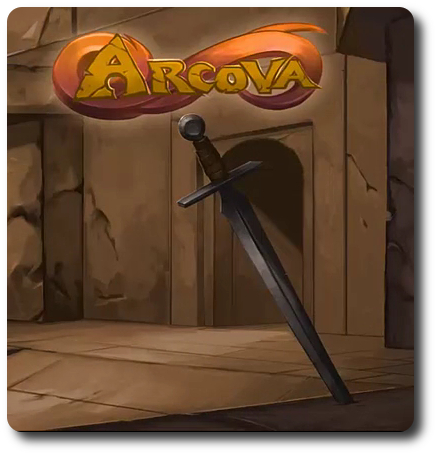
The Basics:
- For ages 7 and up (publisher suggests 12+)
- For 2 to 6 players
- Approximately 90 minutes to complete
Geek Skills:
- Counting & Math
- Logical & Critical Decision Making
- Reading
- Hand/Resource Management
Learning Curve:
- Child – Easy
- Adult – Easy
Theme & Narrative:
- Raise an army to rule the land of Arcova!
Endorsements:
- Gamer Geek rejected!
- Parent Geek rejected!
- Child Geek mixed!
Overview
The land knew nothing but peace under the wise and benevolent rule of King Baelon Rhakal. But all kings must die, and so it was with Rhakal. The throne stood empty and the land mourned. The heirs to the throne fought among themselves for succession and the land began to suffer. Wars, famine, and death soon followed. Now all is in ruin and the mighty kingdom has fallen into dust. You have arisen from this destruction to rebuild the kingdom in your image. Gather your forces and heal the land.
Arcova: Aftermath, designed by Jessie Edwards and published by Drooling Panda Games, is comprised of 1 game board, 2 standard six-sided dice, 6 Player pawns, 6 Armory boards, 6 Slider clips (paperclips, essentially), 45 Retainer cards, 24 Element token (4 Fire, 4 Water, 4 Air, and 4 Earth), 54 Weapon/Magic cards, 52 Armor cards, and 54 Happenstance cards. The Armory boards are made of thick cardstock and large. The Retainer, Magic/Weapon, and Armor cards are as durable as your standard playing card. The colorful game board is mounted on sturdy cardboard. The illustrations by artist Ryan Harasym are very good and add a great deal of character to the game.
Setting Up the Game
To set up the game, first place the game board in the middle of the playing area.
Second, have each player select a Player pawn color of their choice and place it in the “Temple of Order”, a location found in the middle of the game board. Any Player pawns not selected are placed back in the game box.
Third, give to each player 1 Armory board and a Slider clip. Players should place the Slider clip so it’s pointing to the “3” Life points value.
Fourth, shuffle the Retainer cards and deal 1 to each player. Players place their starting Retainer in the Retainer portion of their Armory board. Place the rest of the Retainer cards to one side of the game playing area, face-down. This is the Retainer draw deck for the duration of the game.
Fifth, shuffle the Weapon/Magic, Armor, and Happenstance cards into different decks and place them, face-down, next to the Retainer draw deck. These will be the Weapon/Magic, Armor, and Happenstance draw decks for the duration of the game.
Sixth, place the Element tokens in a pile to one side of the game playing area.
That’s it for game set up. Time to play.
Equipping for Adventure
Each player’s Armory board includes a spot for 1 Retainer card, 2 Armor cards, 1 Magic card, and 1 Weapon card. The Armory board also keeps track of the player’s Life points.
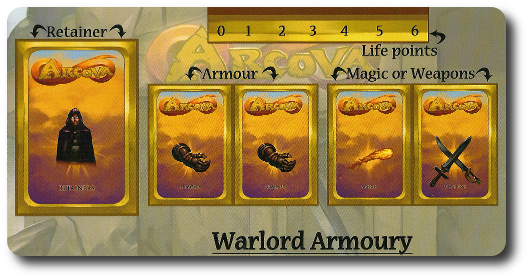
Retainers
Retainers serve as the player’s proxies when it comes to fighting battles. The world of Arcova is filled with a diverse group of humanoids who will gladly join the player’s army. Only one Retainer can be used at a time, however, but the player must gather as many as they can to win support and the game. Each race has its own abilities (also refereed to as traits), strengths, and weaknesses. The Retainer card lists the race’s natural strength and magic, as well as the amount of Gold the race brings to the player’s war chest.
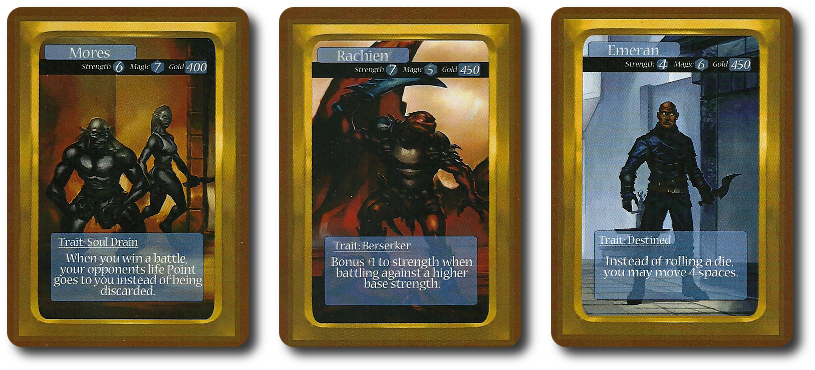
Armor
The Armor cards are specialized and block only certain types of weapons or magical attacks. As such, a player will need to collect as much armor as possible in order to protect their Retainer for any attack.

Weapons and Magic
The Weapon/Magic cards will either show a weapon or a magical spell. Players can use both, but certain races will be able to use spells and weapons to a great degree of proficiency. This means it’s not enough to outfit a Retainer with good equipment. The race of the Retainer should also be considered.
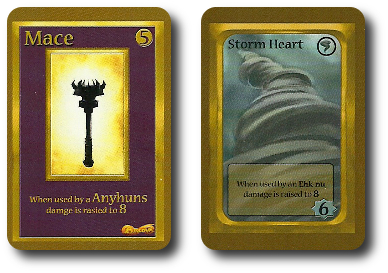
And So Your Legend Begins…
Arcova is played in turns with no set number of turns per game. On a player’s turn, they will complete the following steps.
Step 1: Choose Your Retainer
The player can now switch the Retainer they currently have active on their Armory board. Any Retainer they currently have in their inventory of cards can be selected as a replacement. If a Retainer is replaced, it’s taken into the player’s inventory for later use. Which is to say, players do not lose their Retainers.
Step 2: Move
The first thing a player does is roll a six-sided die to determine how many spaces they may move their Player pawn on the game board. Optionally, a player may use their current Retainer’s movement ability if one is listed. Movement is done by following lines between locations. The player is welcome to move in any direction they like as long as there are lines to follow. A player cannot stop their movement unless the path they are following terminates and a player cannot turn around and go a different direction once they start their movement

Step 2: Encounter the Space
Depending on where a player stopped their Player pawn, they will now take an action. Some actions are mandatory and some are optional.
Blank
The player has encountered nothing.
Death
This space (indicated with a skull and crossbones) immediately reduces the player’s Life points by 1. This is mandatory.
Font of Regeneration
Scattered about the land are magical places (indicated by a healing angel) that will restore a player’s Life points. If the player has less than “3” Life points, they are immediately healed to “3”. If the player had “3” or more Life points, they gain +1 Life point for a maximum of “6” Life points. This is mandatory.
Retainer Recruitment
This space (indicated by the same image that is found on the Retainer cards) allows the player to draw 1 Retainer card and add it to their inventory. This is mandatory.
Elemental Source
There are 4 Element sources found in the land of Arcova. Each Elemental source provides 1 Element token. When a player lands on the Elemental source, they take the associated Element token into their inventory. This is mandatory.
Happenstance
This space (indicated by an arrow and axe) forces the player to draw 1 Happenstance card. Happenstance cards are random events that might or might not be beneficial to the player. They could find an artifact, treasure, or even lose their current Retainer. Some Happenstance cards can be kept in the player’s inventory until used and some are used right away before the player’s turn is over. When Happenstance cards are used, they are discarded.
Weapons/Magic and Armor
These spaces (indicated by the same image found on the Weapon/Magic and Armor cards) allows the player to draw 1 card of the specified type. The card goes into the player’s inventory. This is mandatory
Battle
Landing on this space (indicated with a red starburst) allows the player to engage another opponent in battle. This is optional and combat is explained in more detail in “Warring Warlords”.
Step 3: Adjust Retainer
After the player has completed encountering the space, taking any mandatory or optional actions, they can adjust the Retainer card they have in play on their Armory board with another Retainer they have in their inventory. A Retainer with a good defense is preferable.
This completes the player’s turn. The next player in turn order sequence now repeats the same steps noted above.
Warring Warlords
If a player lands on a Battle space and they chose to fight, they can battle any other player regardless of how far or close they might be to the Player pawn. Combat is straight forward, but should be completed using the following sequential steps.
Step 1: Adjust Armory
The active player can adjust their Armory board by changing their Weapon/Magic and Armory cards. Removed cards are discarded.
Step 2: Declare Battle
The player who is initiating the attack may target any opponent. This opponent is referred to as the defender. Remember that declaring battle is optional, but players must always engage in battle if they are challenged. The attacking player must state if they are using magic or weapons.
Step 3: Defender Can Adjust 1 Card in their Armory
Just like the attacking player, the defending player can now adjust their Armory. However, the defender can only adjust 1 card. Removed cards are discarded. The current Retainer cannot be changed.
Step 4: Defender States Defense with Magic or Weapons
The defending player now states if they are going to use magic or weapons during the battle.
Step 5: Roll and Determine Winner
Both players now roll 1 six-sided die and add this value to the attack type they previously declared.
- Magic uses Magic racial ability + Spell + Dice Value
- Weapon uses Strength racial ability + Weapon + Dice value
If the player is wearing Armor that cancels a Weapon or Spell card their opponent is using, the number value of the canceled Weapon or Spell card is not included.
The player with the higher value wins the battle. Ties are re-rolled. The winner gets to take 1 Weapon, 1 Armor, or 1 Spell card from their opponent’s Armory board. The defeated player looses 1 Life point in addition to the card that was taken.
Life Points and Death
A player’s warlord never really dies in the game, even when their Life points are reduces to zero or less. It’s not directly stated, but they become something like a walking undead. Definitely not natural and that means there are consequences while being in this state of undeath.
- May not collect new Retainers
- May not collect new Weapon, Armor, or Spell cards
- May not collect Element tokens
- May not cast the spell of Unity
- May not attack or be attacked
As soon as a player heals their warlord character so they have at least 1 Life point, they will stop suffering the penalties of being a walking undead.
Winning the Game
The game ends when any player completes the following 3 requirements.
- Has all 4 of the different Element tokens
- Has at least 4,000 gold provided by their Retainers
- Casts the spell of Unity at any of the Temple of Order (where the player’s started)
To cast the spell, the player need only have the gold and the elements and say “I cast the spell”. The instructions suggest the player do more, but it’s not necessary to win the game.
To learn more about Arcova: Aftermath, visit the game designer’s web page or the game’s page on the Game Crafter.
Prediction
The game certainly looks impressive and the easy roll-n-move mechanism will appeal to the Child Geeks who are just now starting to learn more complicated games. I fear, however, that looks alone will not please the Parent and Gamer Geeks. The rules are a bit of a mess to read and to follow, which leads me to believe the game play will suffer a bit until players get the hang of the game.
I predict mixed approvals from the Parent Geeks, rejections from the Gamer Geeks, and approval from the Child Geeks. This is not a complicated game, but it does have some interesting choices for the Child Geeks to make which should keep them engaged. The Parent Geeks and Gamer Geeks are going to get bored with Arcova pretty fast.
Teaching Arcova is not complicated, but understanding the rules can be. I suggest you read them over a few times. After that, it’s just walking through the steps and helping the players remember what they have to do on each space. Pretty simple, really. Note that players do not necessarily need to know how to read or do math to play this game. If the players agreed to put all their cards out on the table, even very young Child Geeks can play. I plan to play with my 4-year-old, for example, since there is no reason why he shouldn’t be able to enjoy Arcova if I am reading the cards for him.
And so, after teaching the game to my 3 oldest little geeks, I asked them their thoughts so far on Arcova: Aftermath.
“Looks neat! And look at all the weapons and guys you can use! Cool!” ~ Liam (age 10)
“I like all the spells you can use. Looks pretty cool.” ~ Nyhus (age 7)
“Can I be all these guys?” (pointing at the Retainer draw deck) ~ Ronan (age 4)
My little geeks are ready to go on their adventure and travel the land of Arcova. Let’s see if it worth the trip or we are better off staying at home.
Final Word
The Child Geeks started off greatly enjoying Arcova and liked how they were able to “explore” the land with each move. Their enthusiasm started to dwindle about 15 minutes into the game as they started to feel that all they were doing was rolling and moving, rolling and moving, rolling and moving. According to one Child Geek, “I don’t know. It’s OK, but I don’t really feel like I’m working to save a world.” Another Child Geek said, “I like battling, but I don’t understand why I should.” This is an excellent point and one that deserves a bit more scrutiny. The game rules suggest but never state that a player can take another player’s Element token. But according to the rules, all a player can collect from an opponent who loses in a fight is 1 Weapon, 1 Armor, or 1 Magic card that is currently active on the opponent’s Armory. This means that all you are really doing is poking at another player and not doing much to slow them down. In the end, Arcova was seen to be too long and too repetitive by some of the Child Geeks and an interesting enough game to give it a thumbs-up from other Child Geeks resulting in a mixed approval.
My 4-year-old could play Arcova and the game play did not suffer from me reading the cards for him. He still made all the decisions, rolled the dice, and fought all the battles. One battle he could not win, however, was boredom. After 15 or minutes of playing, he stepped away from the table and didn’t return.
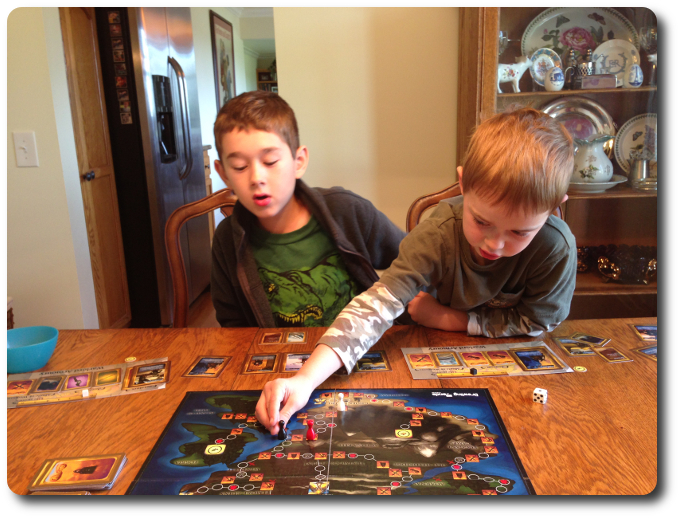
The first half of the game went well, but started to slide downhill after that…
The Parent Geeks suffered through this game for their Child Geeks. According to one Parent Geek, “I don’t want to attack my child and if I do, so what? They will just get another card to replace the one they have. Seems pointless.” Another Parent Geek said, “The game looks great but plays like it’s still being developed.” One aspect of the game the Parent Geeks liked was how each player was able to customize their Retainer, but they quickly came to the conclusion that players didn’t have to do much with their Retainers once they had good amor and weapons equipped. One Parent Geek said, “I like how we can pick between being a magic user or a warrior, and our Retainers are different, but the game is pretty boring.” All of the Parent Geeks had difficulty making out some or all of the very small text on the some of the cards, which just further frustrated them. When all the games were over, the Parent Geek voted to reject Arcova.
The Gamer Geeks did not like this game. There is no need to restate the very colorful and passionate negative commentary they provided. Let’s just all agree that this is not an elitist’s game.
I’ll be blunt. This game is not done being cooked yet. It’s riddled with little things that all add up to a lack luster game offering. Some of the minor offenses include poorly written rules that are missing major details, use mixed terminology, and are generally misleading. There is also a number of major misspellings, including the name of the game being misspelled on the game box cover. On my copy, the game is titled Arcova: After Math. As in after doing some sort of mathematical exercise. The game play starts out unimaginative and quickly snowballs into a redundant exercise of rolling and moving to mindlessly collect 4 Elements. This act of collecting is made even worse by the distance on the game board a player must travel. The end result feels less like an adventure and more like a crucible with the real winner being the one who quits first and gets to walk away to do something else.
And, yes, I know I am sounding harsh, but the amount of bitterness this game caused for our gaming groups is unprecedented. To a point where people were taking it a bit too personally and letting off steam by badmouthing the game to no end. A pity because I’m pretty sure the game was doing the best it could, but there are just to many sloppy mistakes to suggest that the proper amount of time was spent on this game before it was sent to use to play. The production value is excellent, but once you get past how it looks, you start to see lots of flaws.
What Arcova does have going for it is the artwork and the novel idea of collecting proxies to fight a war for you that can be mixed and matched with different armor, weapon, and magic sets. This light resource management aspect of Arcova was an interesting twist and well received. The player’s also liked how certain races got bonuses with certain weapons. This made collecting Retainers fun and not just something that had to be done to win the game.
But that’s about it. Battles, collecting weapons, slapping on armor, learning spells, and even traveling in the fantasy world felt unnecessary and unrewarding fairly quickly and too often. This game has heart, but it isn’t beating as strongly as it should. It needs time to mature, the rules need to be cleaned up, and the game play needs a lot of streamlining. What we have here is the beginning stages of something pretty cool. I hope the game designer takes the criticism with a grain of salt and challenges themselves to make a better game. To quote the game designer, “the world of Arcova is in their hands.”
This game was given to Father Geek as a review copy. Father Geek was not paid, bribed, wined, dined, or threatened in vain hopes of influencing this review. Such is the statuesque and legendary integrity of Father Geek.




Pingback: In Review: Father Geek’s Monthly Newsletter (September 2014) - Father Geek